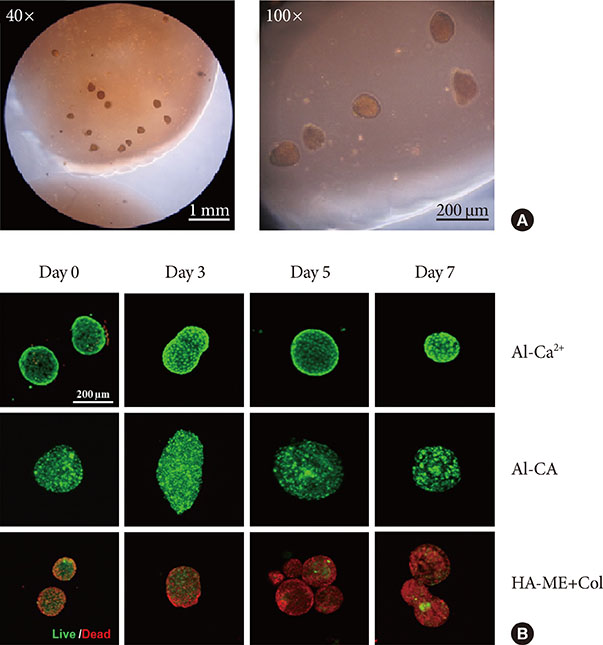Diabetes Metab J.
2018 Apr;42(2):164-168. 10.4093/dmj.2018.42.2.164.
Alginate-Catechol Cross-Linking Interferes with Insulin Secretion Capacity in Isolated Murine Islet Cells
- Affiliations
-
- 1Severance Institute for Vascular and Metabolic Research, Yonsei University College of Medicine, Seoul, Korea. acw@yuhs.ac
- 2Department of Biotechnology, Yonsei University, Seoul, Korea.
- 3Biomedical Research Center, Gangnam Severance Hospital, Yonsei University College of Medicine, Seoul, Korea.
- 4Department of Internal Medicine, Gangnam Severance Hospital, Yonsei University College of Medicine, Seoul, Korea.
- KMID: 2418709
- DOI: http://doi.org/10.4093/dmj.2018.42.2.164
Abstract
- Over the past three decades, human pancreatic islet isolation and transplantation techniques have developed as a routine clinical procedure for selected patients with type 1 diabetes mellitus. However, due to the donor shortage and required chronic systemic immunosuppression, the widespread application of islet transplantation is limited. To overcome these limitations, providing a physical barrier to transplanted islet cells with encapsulating biomaterial has emerged as a promising approach to enhance engraftment and promote islet survival post-transplantation. Alginate has been considered to be a reliable biomaterial, as it enhances islet survival and does not hamper hormone secretion. Alginate-catechol (Al-CA) hydrogel was reported to provide high mechanical strength and chemical stability without deformation over a wide range of pH values. In this study, we, demonstrated, for the first time in the literature, that encapsulation of murine pancreatic islet cells with Al-CA hydrogel does not induce cytotoxicity ex vivo for an extended period; however, it does markedly abate glucose-stimulated insulin secretion. Catechol should not be considered as a constituent for alginate gelation for encapsulating islet cells in the application of islet transplantation.
Keyword
MeSH Terms
Figure
Reference
-
1. Maahs DM, West NA, Lawrence JM, Mayer-Davis EJ. Epidemiology of type 1 diabetes. Endocrinol Metab Clin North Am. 2010; 39:481–497.
Article2. You WP, Henneberg M. Type 1 diabetes prevalence increasing globally and regionally: the role of natural selection and life expectancy at birth. BMJ Open Diabetes Res Care. 2016; 4:e000161.
Article3. Shapiro AM, Pokrywczynska M, Ricordi C. Clinical pancreatic islet transplantation. Nat Rev Endocrinol. 2017; 13:268–277.
Article4. Shapiro AM. State of the art of clinical islet transplantation and novel protocols of immunosuppression. Curr Diab Rep. 2011; 11:345–354.
Article5. Desai T, Shea LD. Advances in islet encapsulation technologies. Nat Rev Drug Discov. 2017; 16:367.
Article6. Souza YE, Chaib E, Lacerda PG, Crescenzi A, Bernal-Filho A, D'Albuquerque LA. Islet transplantation in rodents. Do encapsulated islets really work? Arq Gastroenterol. 2011; 48:146–152.
Article7. de Vos P, Hamel AF, Tatarkiewicz K. Considerations for successful transplantation of encapsulated pancreatic islets. Diabetologia. 2002; 45:159–173.
Article8. Lee YK, Lee SY. A colorimetric alginate-catechol hydrogel suitable as a spreadable pH indicator. Dyes Pigm. 2014; 108:1–6.
Article9. Carter JD, Dula SB, Corbin KL, Wu R, Nunemaker CS. A practical guide to rodent islet isolation and assessment. Biol Proced Online. 2009; 11:3–31.
Article10. Baier Leach J, Bivens KA, Patrick CW Jr, Schmidt CE. Photocrosslinked hyaluronic acid hydrogels: natural, biodegradable tissue engineering scaffolds. Biotechnol Bioeng. 2003; 82:578–589.
Article11. Sakata N, Sumi S, Yoshimatsu G, Goto M, Egawa S, Unno M. Encapsulated islets transplantation: past, present and future. World J Gastrointest Pathophysiol. 2012; 3:19–26.
Article12. Cui J, Wang M, Zheng Y, Rodriguez Muniz GM, del Campo A. Light-triggered cross-linking of alginates with caged Ca2+. Biomacromolecules. 2013; 14:1251–1256.
Article13. Giri TK, Thakur D, Alexander A, Ajazuddin , Badwaik H, Tripathi DK. Alginate based hydrogel as a potential biopolymeric carrier for drug delivery and cell delivery systems: present status and applications. Curr Drug Deliv. 2012; 9:539–555.14. Lee C, Shin J, Lee JS, Byun E, Ryu JH, Um SH, Kim DI, Lee H, Cho SW. Bioinspired, calcium-free alginate hydrogels with tunable physical and mechanical properties and improved biocompatibility. Biomacromolecules. 2013; 14:2004–2013.
Article15. Roshanbinfar K, Salahshour Kordestani S. Encapsulating beta islet cells in alginate, alginate-chitosan and alginate-chitosan-PEG microcapsules and investigation of insulin secretion. J Biomater Tissue Eng. 2013; 3:185–189.
Article16. Korsgren O. Islet encapsulation: physiological possibilities and limitations. Diabetes. 2017; 66:1748–1754.
Article17. de Haan BJ, Faas MM, de Vos P. Factors influencing insulin secretion from encapsulated islets. Cell Transplant. 2003; 12:617–625.
Article18. Hou J, Li C, Guan Y, Zhang Y, Zhu XX. Enzymatically crosslinked alginate hydrogels with improved adhesion properties. Polym Chem. 2015; 6:2204–2213.
Article
- Full Text Links
- Actions
-
Cited
- CITED
-
- Close
- Share
- Similar articles
-
- Alginate Microencapsulation of Islet Cells Using Electrostatic Droplet Generator
- Comparative Study of Two Common In Vitro Models for the Pancreatic Islet with MIN6
- Immunocytochemical Expression of Amylin in Pancreatic Islets of Man, Rabbit and Guinea Pig
- Role of Nitric Oxide on the Insulin Secretion of Rat Pancreas
- Usefulness of Minimal Model Analysis: Measurement of Insulin Sensitivity, Glucose Effectiveness, and Insulin Secretory Capacity from Pancreatic Islet Cells in Children with Simple Obesity or Type 2 Diabetes Mellitus



